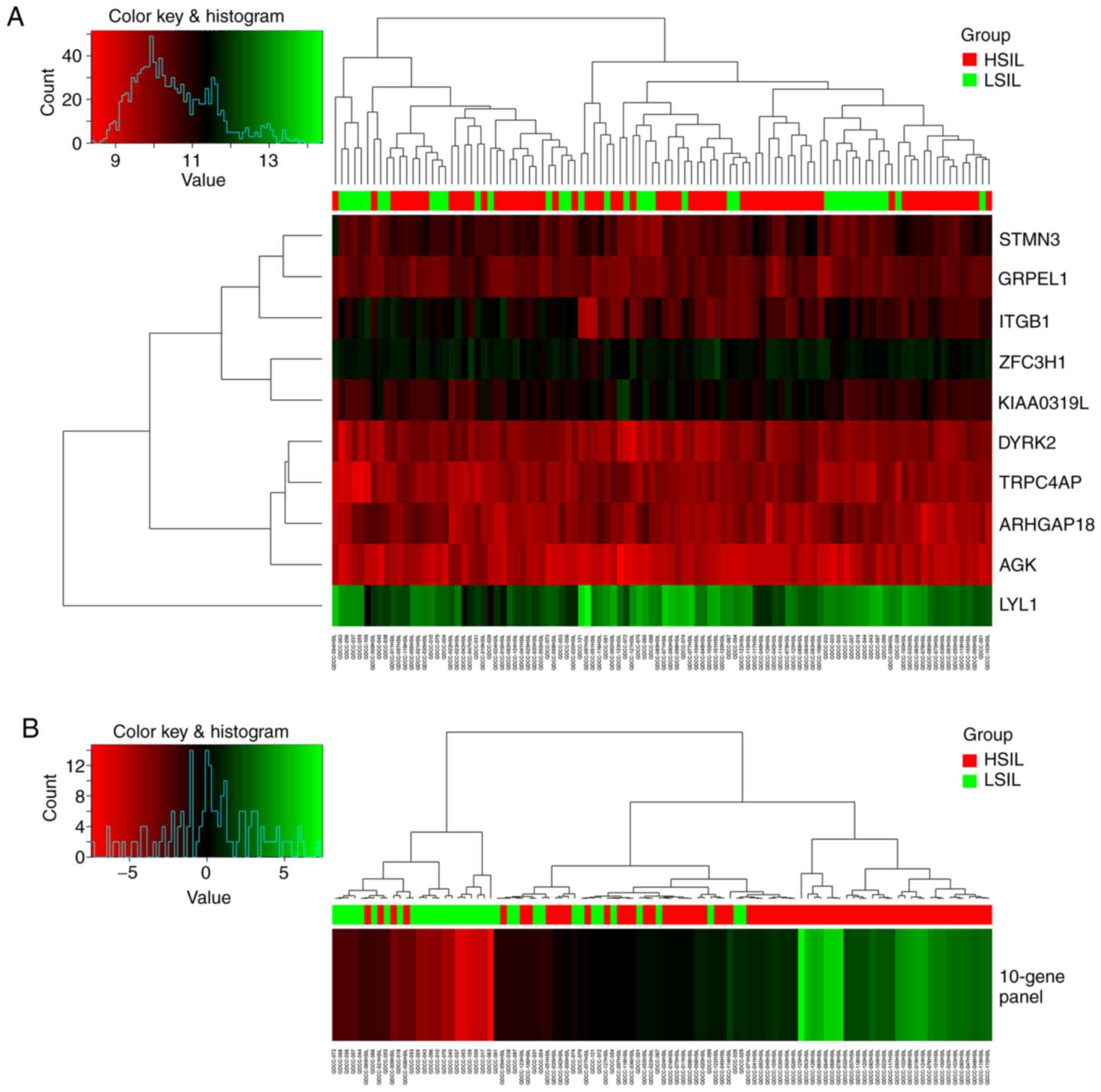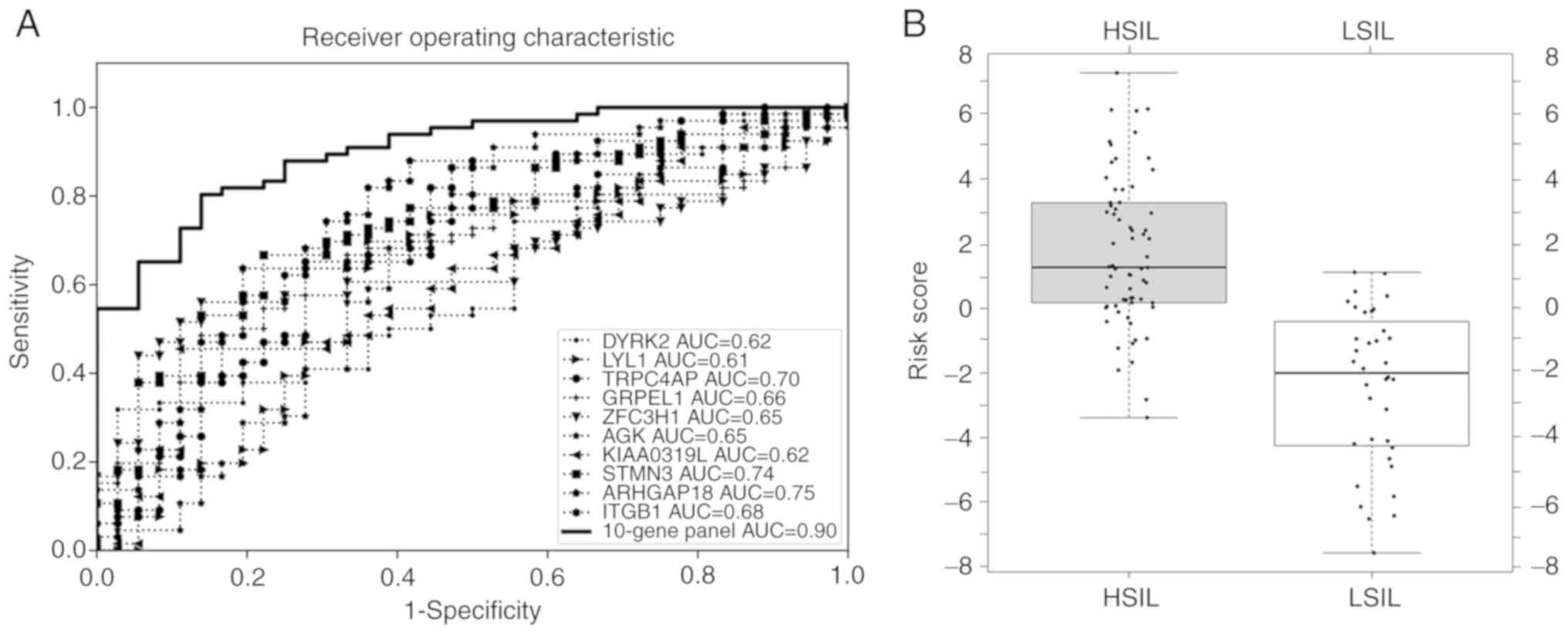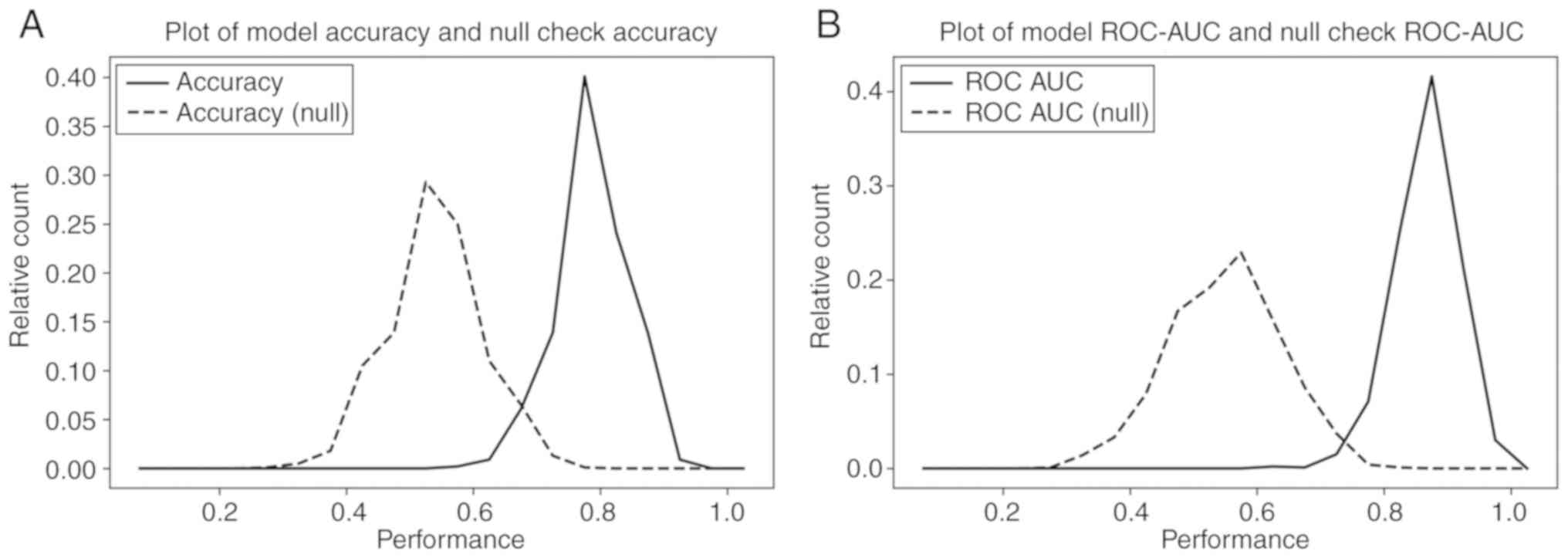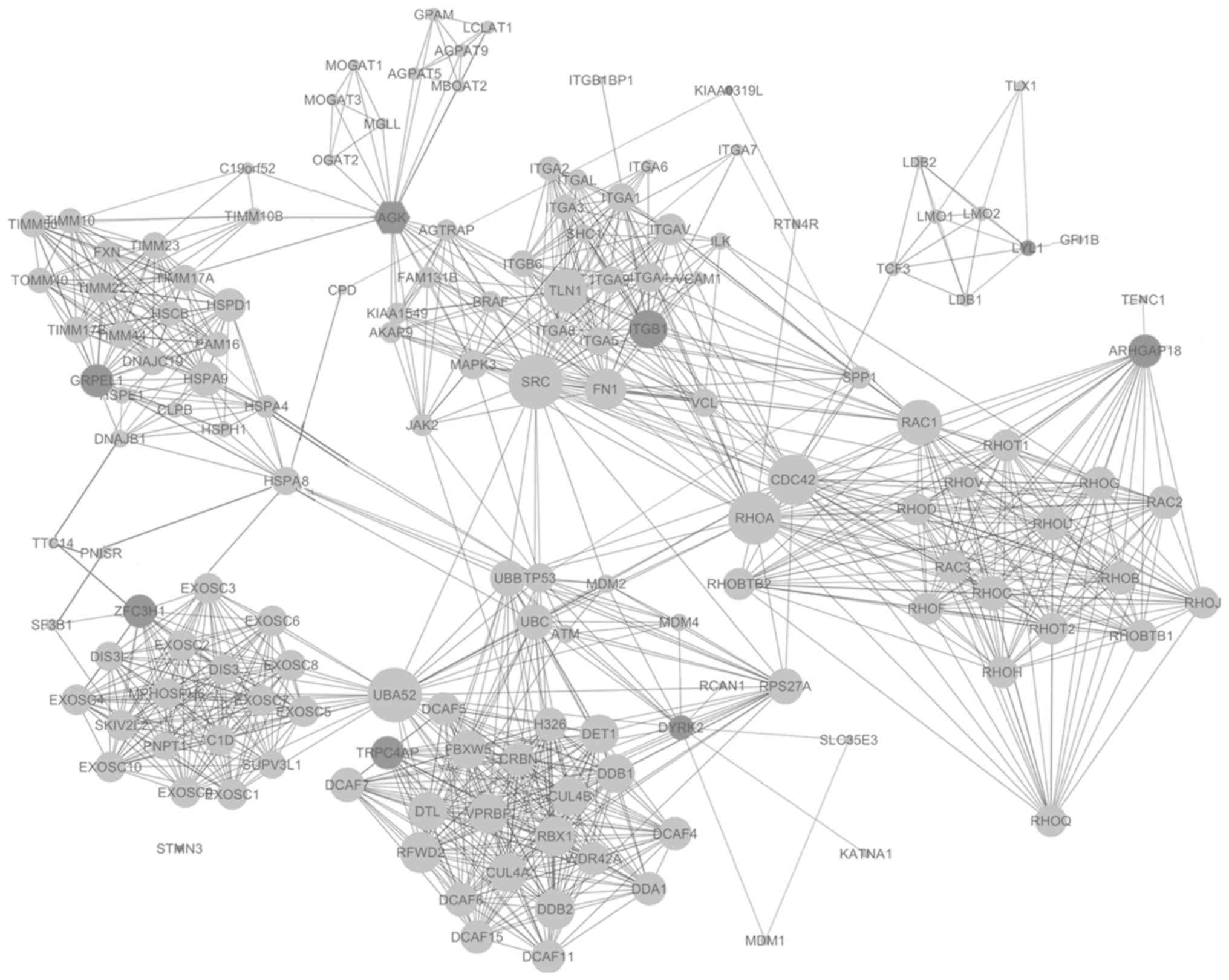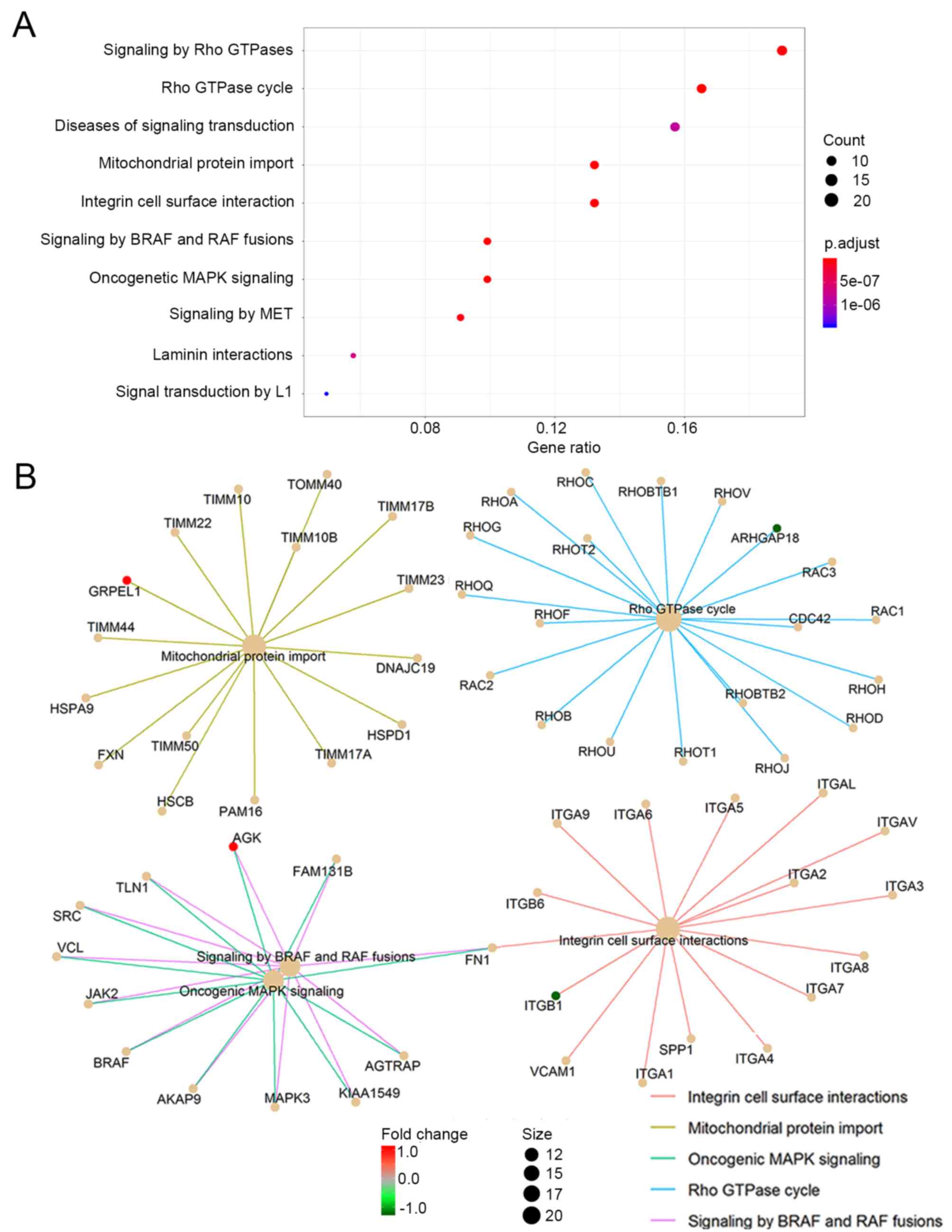|
1
|
Godoy-Vitorino F, Romaguera J, Zhao C,
Vargas-Robles D, Ortiz-Morales G, Vázquez-Sánchez F,
Sanchez-Vázquez M, de la Garza-Casillas M, Martinez-Ferrer M, White
JR, et al: Cervicovaginal fungi and bacteria associated with
cervical intraepithelial neoplasia and high-risk human
papillomavirus infections in a hispanic population. Front
Microbiol. 9:25332018. View Article : Google Scholar : PubMed/NCBI
|
|
2
|
World Health Organization: WHO guidelines
for screening and treatment of precancerous lesions for cervical
cancer prevention. 2013.
|
|
3
|
Reagan JW, Seidemann IL and Saracusa Y:
The cellular morphology of carcinoma in situ and dysplasia or
atypical hyperplasia of the uterine cervix. Cancer. 6:224–234.
1953. View Article : Google Scholar : PubMed/NCBI
|
|
4
|
Richart RM: A theory of cervical
carcinogenesis. Obstet Gynecol Surv. 24:874–879. 1969. View Article : Google Scholar : PubMed/NCBI
|
|
5
|
Hoffman SR, Le T, Lockhart A, Sanusi A,
Dal Santo L, Davis M, McKinney DA, Brown M, Poole C, Willame C and
Smith JS: Patterns of persistent HPV infection after treatment for
cervical intraepithelial neoplasia (CIN): A systematic review. Int
J Cancer. 141:8–23. 2017. View Article : Google Scholar : PubMed/NCBI
|
|
6
|
Voltaggio L, Cimino-Mathews A, Bishop JA,
Argani P, Cuda JD, Epstein JI, Hruban RH, Netto GJ, Stoler MH,
Taube JM, et al: Current concepts in the diagnosis and pathobiology
of intraepithelial neoplasia: A review by organ system. CA Cancer J
Clin. 66:408–436. 2016. View Article : Google Scholar : PubMed/NCBI
|
|
7
|
Nguyen HN and Nordqvist SR: The Bethesda
system and evaluation of abnormal pap smears. Semin Surg Oncol.
16:217–221. 1999. View Article : Google Scholar : PubMed/NCBI
|
|
8
|
Solomon D and Ritu N: The bethesda system
for reporting cervical cytology: Definitions, criteria, and
explanatory notes. Comprehensive cytopathology. 10. pp. 77–90.
2008
|
|
9
|
Darragh TM, Colgan TJ, Thomas Cox J,
Heller DS, Henry MR, Luff RD, McCalmont T, Nayar R, Palefsky JM,
Stoler MH, et al: The lower anogenital squamous terminology
standardization project for HPV-associated lesions: Background and
consensus recommendations from the College of American pathologists
and the American society for colposcopy and cervical pathology. Int
J Gynecol Pathol. 32:76–115. 2013. View Article : Google Scholar : PubMed/NCBI
|
|
10
|
Stoler MH, Ronnett BM, Joste NE, Hunt WC,
Cuzick J and Wheeler CM; New Mexico HPV Pap Registry Steering
Committee, : The interpretive variability of cervical biopsies and
its relationship to HPV status. Am J Surg Pathol. 39:729–36. 2015.
View Article : Google Scholar : PubMed/NCBI
|
|
11
|
Charoonwatana T, Boonlikit S and Yanaranop
M: Progression of precancerous cervical lesion predicted by p16
protein immunohistochemistry in Rajavithi Hospital. Asian Pac J
Cancer Prev. 20:1809–1815. 2019. View Article : Google Scholar : PubMed/NCBI
|
|
12
|
Lu Z and Chen J: Introduction of WHO
classification of tumours of female reproductive organs fourth
edition. Zhonghua Bing Li Xue Za Zhi. 43:649–650. 2014.(In
Chinese). PubMed/NCBI
|
|
13
|
Liu Y, Alqatari M, Sultan K, Ye F, Gao D,
Sigel K, Zhang D and Kalir T: Using p16 immunohistochemistry to
classify morphologic cervical intraepithelial neoplasia 2:
Correlation of ambiguous staining patterns with HPV subtypes and
clinical outcome. Hum Pathol. 66:144–151. 2017. View Article : Google Scholar : PubMed/NCBI
|
|
14
|
Wentzensen N, Bergeron C, Cas F,
Eschenbach D, Vinokurova S and von Knebel Doeberitz M: Evaluation
of a nuclear score for p16INK4a-stained cervical squamous cells in
liquid-based cytology samples. Cancer. 105:461–467. 2005.
View Article : Google Scholar : PubMed/NCBI
|
|
15
|
Liu Y, Sigel K and Gaisa MM: Human
papillomavirus genotypes predict progression of anal low-grade
squamous intraepithelial lesions. J Infect Dis. 218:1746–1752.
2018. View Article : Google Scholar : PubMed/NCBI
|
|
16
|
Johnson CA, James D, Marzan A and Armaos
M: Cervical cancer: An overview of pathophysiology and management.
Semin Oncol Nurs. 35:166–174. 2019. View Article : Google Scholar : PubMed/NCBI
|
|
17
|
Schwarzenbach H, Hoon DS and Pantel K:
Cell-free nucleic acids as biomarkers in cancer patients. Nat Rev
Cancer. 11:426–437. 2011. View Article : Google Scholar : PubMed/NCBI
|
|
18
|
Liew CC: Method for detection of gene
transcripts in blood and uses thereof. 2009.
|
|
19
|
Shi J, Cheng C, Ma J, Liew CC and Geng X:
Gene expression signature for detection of gastric cancer in
peripheral blood. Oncol Lett. 15:9802–9810. 2018.PubMed/NCBI
|
|
20
|
Omar H, Lim CR, Chao S, Lee MM, Bong CW,
Ooi EJ, Yu CG, Tan SS, Abu Hassan MR, Menon J, et al: Blood gene
signature for early hepatocellular carcinoma detection in patients
with chronic hepatitis B. J Clin Gastroenterol. 49:150–157. 2015.
View Article : Google Scholar : PubMed/NCBI
|
|
21
|
Mok CS, Kim JH, Skates SJ, Schorge JO,
Cramer DW, Lu KH and Liew CC: Use of blood-based mRNA profiling to
identify biomarkers for ovarian cancer screening. Gynecol Obstet
(Sunnyvale). 7:4432017. View Article : Google Scholar
|
|
22
|
Marshall KW, Mohr S, Khettabi FE, Nossova
N, Chao S, Bao W, Ma J, Li XJ and Liew CC: A blood-based biomarker
panel for stratifying current risk for colorectal cancer. Int J
Cancer. 126:1177–1186. 2010.PubMed/NCBI
|
|
23
|
Monsonego J, Hudgens MG, Zerat L, Zerat
JC, Syrjӓnen K, Halfon P, Ruiz F and Smith JS: Evaluation of
oncogenic human papillomavirus RNA and DNA tests with liquid-based
cytology in primary cervical cancer screening: The FASE study. Int
J Cancer. 129:691–701. 2011. View Article : Google Scholar : PubMed/NCBI
|
|
24
|
Ratnam S, Coutlee F, Fontaine D, Bentley
J, Escott N, Ghatage P, Gadag V, Holloway G, Bartellas E, Kum N, et
al: Aptima HPV E6/E7 mRNA test is as sensitive as hybrid capture 2
assay but more specific at detecting cervical precancer and cancer.
J Clin Microbiol. 49:557–564. 2011. View Article : Google Scholar : PubMed/NCBI
|
|
25
|
Nayar R and Wilbur DC: The Bethesda system
for reporting cervical cytology. Definitions, criteria, and
explanatory Notes. 3rd. Springer International Publishing; Cham,
Switzerland: 2015
|
|
26
|
MAQC Consortium, . Shi L, Reid LH, Jones
WD, Shippy R, Warrington JA, Baker SC, Collins PJ, de Longueville
F, Kawasaki ES, et al: The microarray quality control (MAQC)
project shows inter- and intraplatform reproducibility of gene
expression measurements. Nat Biotechnol. 24:1151–1161. 2006.
View Article : Google Scholar : PubMed/NCBI
|
|
27
|
Qi Z, Meng F, Tian Y, Niu L, Shi Y and
Zhang P: Adaboost-LLP: A boosting method for learning with label
proportions. IEEE Trans Neural Netw Learn Syst. 29:3548–3559. 2018.
View Article : Google Scholar : PubMed/NCBI
|
|
28
|
Chao S, Cheng C and Liew CC: Mining the
dynamic genome: A method for identifying multiple disease
signatures using quantitative RNA expression analysis of a single
blood sample. Microarrays (Basel). 4:671–689. 2015. View Article : Google Scholar : PubMed/NCBI
|
|
29
|
Obayashi T, Kagaya Y, Aoki Y, Tadaka S and
Kinoshita K: COXPRESdb v7: A gene coexpression database for 11
animal species supported by 23 coexpression platforms for technical
evaluation and evolutionary inference. Nucleic Acids Res. 47(D1):
D55–D62. 2019. View Article : Google Scholar : PubMed/NCBI
|
|
30
|
Yu G, Wang LG, Han Y and He QY:
ClusterProfiler: An R package for comparing biological themes among
gene clusters. OMICS. 16:284–287. 2012. View Article : Google Scholar : PubMed/NCBI
|
|
31
|
Tcherkezian J and Lamarche-Vane N: Current
knowledge of the large RhoGAP family of proteins. Biol Cell.
99:67–86. 2007. View Article : Google Scholar : PubMed/NCBI
|
|
32
|
McCormack PL: Quadrivalent human
papillomavirus (types 6, 11, 16, 18) recombinant vaccine
(gardasil(®)): A review of its use in the prevention of
premalignant anogenital lesions, cervical and anal cancers, and
genital warts. Drugs. 74:1253–1283. 2014. View Article : Google Scholar : PubMed/NCBI
|
|
33
|
Stanley MA and Sterling JC: Host responses
to infection with human papillomavirus. Curr Probl Dermatol.
45:58–74. 2014. View Article : Google Scholar : PubMed/NCBI
|
|
34
|
Steenbergen RD, Snijders PJ, Heideman DA
and Meijer CJ: Clinical implications of (epi)genetic changes in
HPV-induced cervical precancerous lesions. Nat Rev Cancer.
14:395–405. 2014. View Article : Google Scholar : PubMed/NCBI
|
|
35
|
Bierkens M, Wilting SM, Wieringen WN, van
de Wiel MA, Ylstra B, Meijer CJ, Snijders PJ and Steenbergen RD:
HPV type-related chromosomal profiles in high-grade cervical
intraepithelial neoplasia. BMC Cancer. 12:362012. View Article : Google Scholar : PubMed/NCBI
|
|
36
|
Karia N, Van Loon A, Simoens C, Benoy I
and Bogers J: The positive predictive value of high-grade squamous
intraepithelial lesion on cytology for the histological diagnosis
of cervical intraepithelial neoplasia 2 or higher: A systematic
review. Acta Cytol. 63:206–214. 2019. View Article : Google Scholar : PubMed/NCBI
|
|
37
|
Mohr S and Liew CC: The peripheral-blood
transcriptome: New insights into disease and risk assessment.
Trends Mol Med. 13:422–432. 2007. View Article : Google Scholar : PubMed/NCBI
|
|
38
|
Osman I, Bajorin DF, Sun TT, Zhong H,
Douglas D, Scattergood J, Zheng R, Han M, Marshall KW and Liew CC:
Novel blood biomarkers of human urinary bladder cancer. Clin Cancer
Res. 12:3374–3380. 2006. View Article : Google Scholar : PubMed/NCBI
|
|
39
|
Chao S, Ying J, Liew G, Marshall W, Liew
CC and Burakoff R: Blood RNA biomarker panel detects both left- and
right-sided colorectal neoplasms: A case-control study. J Exp Clin
Cancer Res. 32:442013. View Article : Google Scholar : PubMed/NCBI
|
|
40
|
Nicolas E, Tricarico R, Savage M, Golemis
EA and Hall MJ: Disease-associated genetic variation in human
mitochondrial protein import. Am J Hum Genet. 104:784–801. 2019.
View Article : Google Scholar : PubMed/NCBI
|
|
41
|
Guerra F, Guaragnella N, Arbini AA, Bucci
C, Giannattasio S and Moro L: Mitochondrial dysfunction: A novel
potential driver of epithelial-to-mesenchymal transition in cancer.
Front Oncol. 7:2952017. View Article : Google Scholar : PubMed/NCBI
|
|
42
|
Raimundo N: Mitochondrial pathology:
Stress signals from the energy factory. Trends Mol Med. 20:282–292.
2014. View Article : Google Scholar : PubMed/NCBI
|
|
43
|
Madamba SM, Damri KN, Dejean LM and
Peixoto PM: Mitochondrial ion channels in cancer transformation.
Front Oncol. 5:1202015. View Article : Google Scholar : PubMed/NCBI
|
|
44
|
Seervi M, Sumi S, Chandrasekharan A,
Sharma AK and Santhosh Kumar TR: Molecular profiling of anastatic
cancer cells: Potential role of the nuclear export pathway. Cell
Oncol (Dordr). 42:645–661. 2019. View Article : Google Scholar : PubMed/NCBI
|
|
45
|
Neupert W and Brunner M: The protein
import motor of mitochondria. Nat Rev Mol Cell Biol. 3:555–565.
2002. View
Article : Google Scholar : PubMed/NCBI
|
|
46
|
Srivastava S, Savanur MA, Sinha D, Birje
A, R V, Saha PP and D'Silva P: Regulation of mitochondrial protein
import by the nucleotide exchange factors GrpEL1 and GrpEL2 in
human cells. J Biol Chem. 292:18075–18090. 2017. View Article : Google Scholar : PubMed/NCBI
|
|
47
|
Cherfils J and Zeghouf M: Regulation of
small GTPases by GEFs, GAPs, and GDIs. Physiol Rev. 93:269–309.
2013. View Article : Google Scholar : PubMed/NCBI
|
|
48
|
Karlsson R, Pedersen ED, Wang Z and
Brakebusch C: Rho GTPase function in tumorigenesis. Biochim Biophys
Acta. 1796:91–98. 2009.PubMed/NCBI
|
|
49
|
Jansen S, Gosens R, Wieland T and Schmidt
M: Paving the Rho in cancer metastasis: Rho GTPases and beyond.
Pharmacol Ther. 183:1–21. 2018. View Article : Google Scholar : PubMed/NCBI
|
|
50
|
Chaker M, Minden A, Chen S, Weiss RH,
Chini EN, Mahipal A and Azmi AS: Rho GTPase effectors and NAD
metabolism in cancer immune suppression. Expert Opin Ther Targets.
22:9–17. 2018. View Article : Google Scholar : PubMed/NCBI
|
|
51
|
Mendoza-Catalán MA, Cristóbal-Mondragón
GR, Adame-Gómez J, del Valle-Flores HN, Coppe JF, Sierra-López L,
Romero-Hernández MA, del Carmen Alarcón-Romero L, Illades-Aguiar B
and Castañeda-Saucedo E: Nuclear expression of Rac1 in cervical
premalignant lesions and cervical cancer cells. BMC Cancer.
12:1162012. View Article : Google Scholar : PubMed/NCBI
|
|
52
|
Yuan B, Cui J, Wang W and Deng K: Gα12/13
signaling promotes cervical cancer invasion through the
RhoA/ROCK-JNK signaling axis. Biochem Biophys Res Commun.
473:1240–1246. 2016. View Article : Google Scholar : PubMed/NCBI
|
|
53
|
Liu X, Chen D and Liu G: Overexpression of
RhoA promotes the proliferation and migration of cervical cancer
cells. Biosci Biotechnol Biochem. 78:1895–1901. 2014. View Article : Google Scholar : PubMed/NCBI
|
|
54
|
Maeda M, Hasegawa H, Hyodo T, Ito S, Asano
E, Yuang H, Funasaka K, Shimokata K, Hasegawa Y, Hamaguchi M and
Senga T: ARHGAP18, a GTPase-activating protein for RhoA, controls
cell shape, spreading, and motility. Mol Biol Cell. 22:3840–3852.
2011. View Article : Google Scholar : PubMed/NCBI
|
|
55
|
Aleskandarany MA, Sonbul S, Surridge R,
Mukherjee A, Caldas C, Diez-Rodriguez M, Ashankyty I, Albrahim KI,
Elmouna AM, Aneja R, et al: Rho-GTPase activating-protein 18: A
biomarker associated with good prognosis in invasive breast cancer.
Br J Cancer. 117:1176–1184. 2017. View Article : Google Scholar : PubMed/NCBI
|
|
56
|
Desgrosellier JS and Cheresh DA: Integrins
in cancer: Biological implications and therapeutic opportunities.
Nat Rev Cancer. 10:9–22. 2010. View Article : Google Scholar : PubMed/NCBI
|
|
57
|
Pan B, Guo J, Liao Q and Zhao Y: β1 and β3
integrins in breast, prostate and pancreatic cancer: A novel
implication. Oncol Lett. 15:5412–5416. 2018.PubMed/NCBI
|
|
58
|
Manavi M, Hudelist G, Fink-Retter A,
Gschwandtler-Kaulich D, Pischinger K and Czerwenka K: Gene
profiling in Pap-cell smears of high-risk human
papillomavirus-positive squamous cervical carcinoma. Gynecol Oncol.
105:418–426. 2007. View Article : Google Scholar : PubMed/NCBI
|
|
59
|
Zhang W, Zhang M, Liu L, Jin D, Wang P and
Hu J: MicroRNA-183-5p inhibits aggressiveness of cervical cancer
cells by targeting integrin subunit beta 1 (ITGB1). Med Sci Monit.
24:7137–7145. 2018. View Article : Google Scholar : PubMed/NCBI
|
|
60
|
Bektas M, Payne SG, Liu H, Goparaju S,
Milstien S and Spiegel S: A novel acylglycerol kinase that produces
lysophosphatidic acid modulates cross talk with EGFR in prostate
cancer cells. J Cell Biol. 169:801–811. 2005. View Article : Google Scholar : PubMed/NCBI
|
|
61
|
Nouh MA, Wu XX, Okazoe H, Tsunemori H,
Haba R, Abou-Zeid AM, Saleem MD, Inui M, Sugimoto M, Aoki J and
Kakehi Y: Expression of autotaxin and acylglycerol kinase in
prostate cancer: Association with cancer development and
progression. Cancer Sci. 100:1631–1638. 2009. View Article : Google Scholar : PubMed/NCBI
|
|
62
|
Wang X, Lin C, Zhao X, Liu A, Zhu J, Li X
and Song L: Acylglycerol kinase promotes cell proliferation and
tumorigenicity in breast cancer via suppression of the FOXO1
transcription factor. Mol Cancer. 13:1062014. View Article : Google Scholar : PubMed/NCBI
|
|
63
|
Chen X, Ying Z, Lin X, Lin H, Wu J, Li M
and Song L: Acylglycerol kinase augments JAK2/STAT3 signaling in
esophageal squamous cells. J Clin Invest. 123:2576–2589. 2013.
View Article : Google Scholar : PubMed/NCBI
|
|
64
|
Cui Y, Lin C, Wu Z, Liu A, Zhang X, Zhu J,
Wu G, Wu J, Li M, Li J and Song L: AGK enhances angiogenesis and
inhibits apoptosis via activation of the NF-κB signaling pathway in
hepatocellular carcinoma. Oncotarget. 5:12057–12069. 2014.
View Article : Google Scholar : PubMed/NCBI
|
|
65
|
Sun F, Xiong Y, Zhou XH, Li Q, Xiao L,
Long P, Li LJ, Cai MY, Wei YX, Ma YL and Yu YH: Acylglycerol kinase
is over-expressed in early-stage cervical squamous cell cancer and
predicts poor prognosis. Tumour Biol. 37:6729–6736. 2016.
View Article : Google Scholar : PubMed/NCBI
|
|
66
|
Gius D, Funk MC, Chuang EY, Feng S,
Huettner PC, Nguyen L, Bradbury CM, Mishra M, Gao S, Buttin BM, et
al: Profiling microdissected epithelium and stroma to model genomic
signatures for cervical carcinogenesis accommodating for
covariates. Cancer Res. 67:7113–7123. 2007. View Article : Google Scholar : PubMed/NCBI
|
|
67
|
Bauer NC, Detsch PW and Corbett AH:
Mechanisms regulating protein localization. Traffic. 16:1039–1061.
2015. View Article : Google Scholar : PubMed/NCBI
|
|
68
|
Kang Y, Fielden LF and Stojanovski D:
Mitochondrial protein transport in health and disease. Semin Cell
Dev Biol. 76:142–153. 2018. View Article : Google Scholar : PubMed/NCBI
|
|
69
|
Hanahan D and Weinberg RA: Hallmarks of
cancer: The next generation. Cell. 144:646–674. 2011. View Article : Google Scholar : PubMed/NCBI
|
|
70
|
Molina JR and Adjei AA: The Ras/Raf/MAPK
pathway. J Thorac Oncol. 1:7–9. 2006. View Article : Google Scholar : PubMed/NCBI
|
|
71
|
Kotiadis VN, Duchen MR and Osellame LD:
Mitochondrial quality control and communications with the nucleus
are important in maintaining mitochondrial function and cell
health. Biochim Biophys Acta. 1840:1254–1265. 2014. View Article : Google Scholar : PubMed/NCBI
|
|
72
|
Fouad YA and Aanei C: Revisiting the
hallmarks of cancer. Am J Cancer Res. 7:1016–1036. 2017.PubMed/NCBI
|















